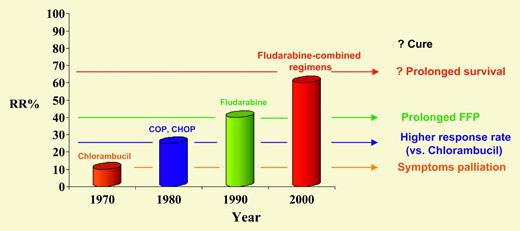Comment on Byrd et al, page 49
Fludarabine plus rituximab seems to be superior to fludarabine alone in the treatment of patients with CLL.
For almost 40 years since its introduction in the 1950s, chlorambucil was the mainstay for the treatment of patients with chronic lymphocytic leukemia (CLL). While this resulted in the palliation of symptoms, it had only a modest impact, if any, on survival. The lack of truly effective therapies, coupled with the notion that in most instances the disease has an indolent course, led to a nihilistic and detrimental approach toward the management of CLL. In the 1970s, Rai and Binet independently developed simple and reproducible prognostic systems allowing patients with CLL to be classified into different risk groups, making it clear that in some instances the prognosis of patients with CLL is extremely poor.1,2 Shortly afterwards, more effective therapies for CLL, mainly purine analogs, became available. This revived interest in CLL, and made it possible to design clinical trials based on the individual risk of each patient. Studies carried out in the 1970s demonstrated that, in patients in early-stage CLL, chlorambucil administered immediately after diagnosis did not yield better results than treatment with the same agent upon disease progression, and that patients in advancedstage combination chemotherapy regimens used at that time (ie, cyclophosphamidevincristine-prednisone [COP]; cyclophosphamide-doxorubicin-prednisone [CAP]; cyclophosphamide-doxorubicin-vincristineprednisone [CHOP]) produced higher response rates than alkylating agents but not longer survival rates.3 It was also found that fludarabine produced not only higher response rates but also a longer disease-free progression than chlorambucil, a first real advance in the treatment of CLL.4 More recently, treatment of CLL has switched to chemotherapy regimens built around purine analogs, particularly fludarabine, with or without mononoclonal antibodies and other cytotoxic agents that enhance the effect of the purine analogs.
In line with the above, the Cancer and Leukemia Group B (CALGB) conducted a phase 2 study (CALGB 9712) to determine the efficacy, safety, and optimal administration schedule of rituximab with fludarabine in previously untreated patients with CLL, rituximab being given either after fludarabine or concurrently.5 The overall response rate with the concurrent regimen was 90% (47% complete response [CR]) compared with 77% (28% CR) in the sequential arm, the conclusion being that rituximab administered concurrently was quite effective at inducing CR and that it appeared to be superior to fludarabine (an agent with which only around a 20% CR rate is obtained) and sequential fludarabine followed by rituximab. It should be noted however, that patients allocated in the sequential arm received less rituximab (4 doses) than those in whom rituximab was given concurrently (10-11 doses). Because of this, the optimum schedule for rituximab cannot be considered as having been definitively settled.FIG1
Chronic lymphocytic leukemia: response rate and treatment goals over the years
Chronic lymphocytic leukemia: response rate and treatment goals over the years
It is against this background that, in this issue of Blood, Byrd et al present a retrospective comparison of 2 different cohorts of patients: one treated with fludarabine alone (CALGB 9011, n = 178) and the other receiving fludarabine and rituximab(CALGB9712, n = 104), as summarized in the previous paragraph. All end points analyzed (overall response, CR, progression-free survival [PFS], and overall survival) favor the combination of fludarabine plus rituximab over fludarabine alone. The CR rate was 38% among those patients receiving fludarabine plus rituximab (versus 20% among patients treated with fludarabine alone), whereas the 2-year PFS and overall survival rates were 67% (versus 45%) and 93% (versus 81%), respectively. Given the retrospective nature of the study and the short follow-up, the authors cautiously—and wisely—conclude that the addition of rituximab to fludarabine may prolong PFS and overall survival in previously untreated patients with CLL.
The important message from these and other similar studies, in which purine analogs are given along with cyclophosphamide or cyclophosphamide and mitoxantrone, with or without rituximab or alemtuzumab, is that there is progress in the treatment of CLL.5-7 As response rates increase, the objectives of therapy change: from palliation to, hopefully, cure (see figure). And while it will be many years before data on overall survival (the ultimate proof) become available, the data on CR and freedom from progression (FFP) are compelling and already point to the superiority of fludarabine-based regimens over fludarabine alone and, needless to say, chlorambucil. So even though we do not know yet what the “gold standard” for treating CLL will be in the new century, we now know that neither chlorambucil nor fludarabine alone are the answer.
After too many years of stagnation, advances in CLL therapy are finally being made. More trials (that stratify patients not only on the basis of the clinical stage, but also according to important biologic prognostic markers such as cytogenetics and ZAP-70 expression) are still needed. The next generation of studies in the treatment of CLL should investigate, among other aspects, the role of different modalities of immune manipulation in the management of this disease, since killing the “last” CLL leukemic cell with chemotherapy or chemoimmunotherapy only can turn out to be a very difficult, if not impossible, task. It is known, thanks to transplantation studies, that CLL cells are extremely sensitive to immune-mediated control.8 Only in this way will advances in the treatment of CLL continue to be made.


